Kerala and the end of this tale
Posted on Thursday, July 25th, 2013 at 11:58 am
We have heard much about Kerala in the deep south of India – it has been on my list for many years. We will arrive in Kochi right in the middle of the south-west monsoon which is interesting in itself. Fort Kochi is billed as an interesting ex-Portugese settlement and we are looking forward to exploring. The taxi from the airport takes one and a half hours – once again there is a lot of traffic – but with a short, crowded ferry crossing here we are. It is humid and cloudy, but not actually raining, although the taxi driver tells us that it was raining heavily until yesterday.
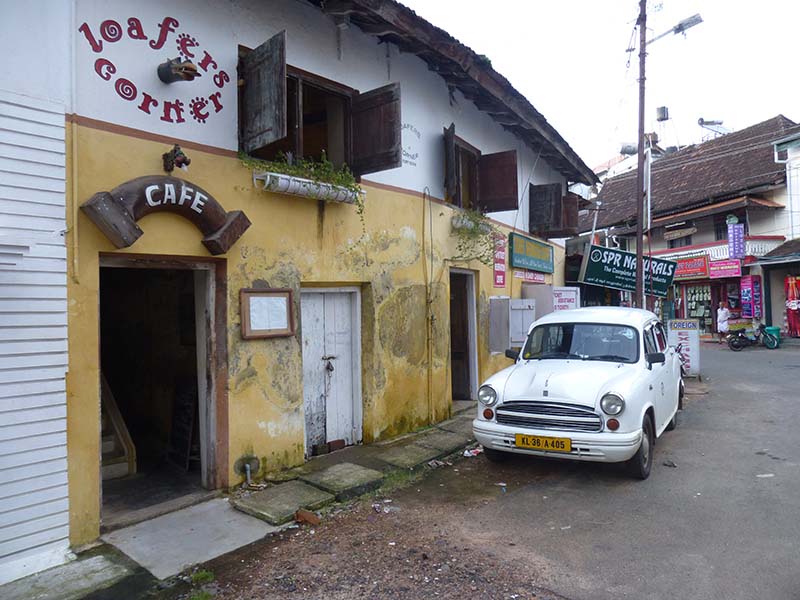
We walk around the old town and out to the promenade and beach, and it is not the old buildings that we notice, although they are quite impressive, but the amount of rubbish around, especially on the beach. The beach is right on the entrance to the main harbour and small fishing boats scurry around the large ships as they steam up the channel. The beach is strewn with rubbish and we find ourselves amazed that no one seems to think anything of it. Around the corner to the south the ocean beach is off limits since it has been taken over by the Indian Navy. One good thing, however, is that all the large fishing boats are not allowed to fish during the rainy season so that the fish stocks can be maintained. I take the classic picture of the chinese fishing nets in the sunset and think of the things the photo doesn’t show.
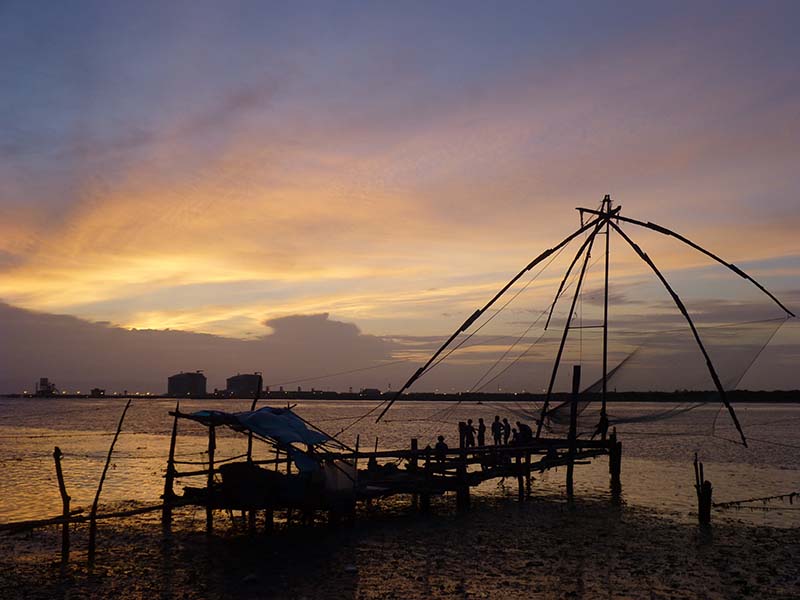
Although the old part of Fort Kochi is under a heritage order, I suspect that one way around this ban is to simply completely neglect a building until it actually falls down. This means that the well kept portuguese houses are interspersed with wrecks. You may be gathering that Fort Kochi is not feeling like a high spot.
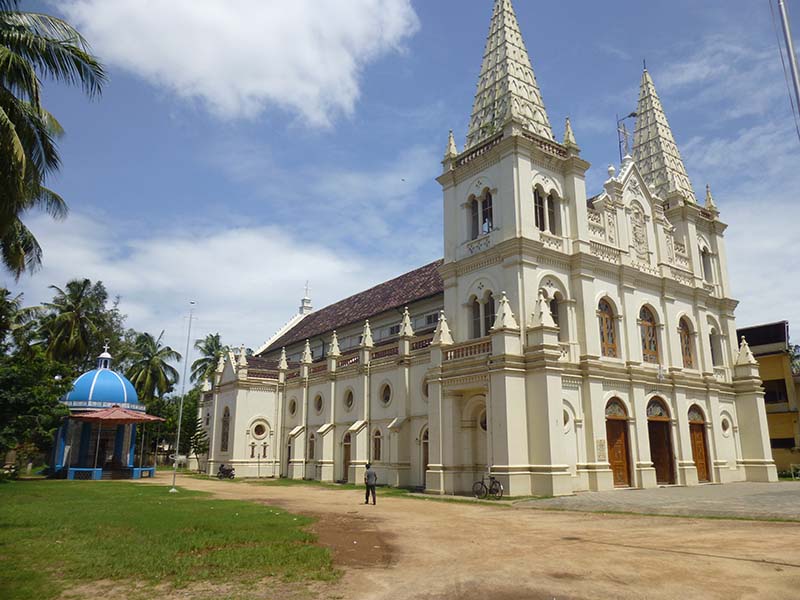
One exception was the Santa Cruz Basilica. Kerela is a predominently Christian state and there are churches everywhere; well maintained and well attended. Wikipedia says of the Basilica :-
“The church was built originally by the Portuguese and elevated to a Cathedral by Pope Paul IV in 1558, was spared by the Dutch conquerors who destroyed many Catholic buildings. Later the British demolished the structure and Bishop D. João Gomes Ferreira commissioned a new building in 1887. Consecrated in 1905, Santa Cruz was proclaimed a Basilica by Pope John Paul II in 1984.”.
It is a beautiful building and we wander around it for some time.
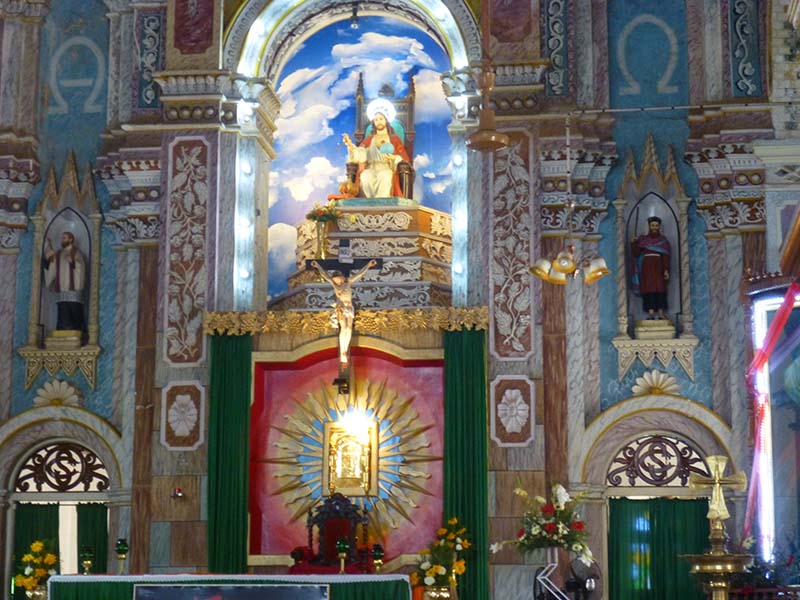
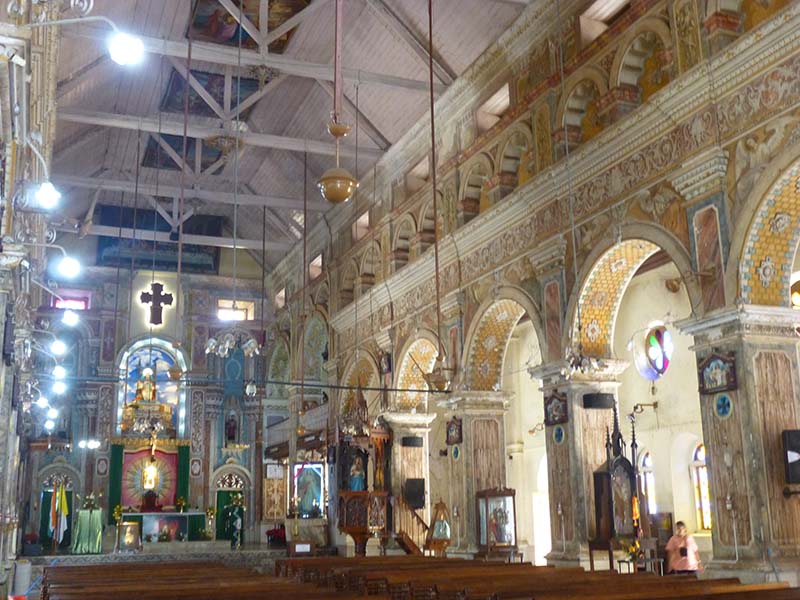
Ok … so time to move on. We decide to take a taxi up to Munnar because any other way seems too difficult. Actually we are making for the small village of Chinnakanal where we are booked into a fancy resort courtesy of a holiday “package” we are a part of. The Sterling Terrace Greens is one of the “partner resorts”. We have no idea what we are letting ourselves in for as we wind our way up into the rainforest covered hills. It reminds us of the rainforest at home … Queensland that is … lots of thick forest, palm trees, lantana, bamboo, bananas, big leafy things, more lantana and so on, with every available space taken up by something growing. Beautiful waterfalls cascade down the steep slopes.
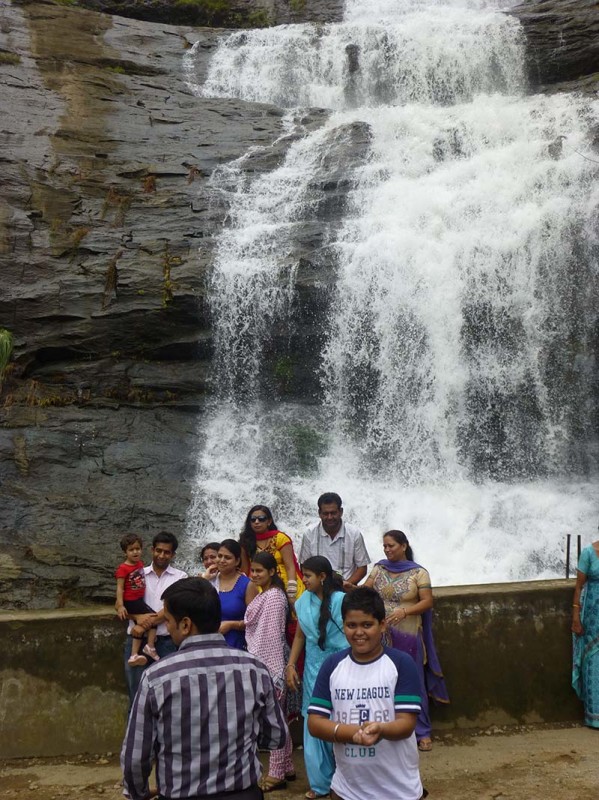
We pass through Munnar at 2200 metres (7000 feet) and up into the tea plantations that this area is famous for. Tea bushes stretch in every direction across the hillsides with silky oaks planted at intervals through the plantations. There are also lots of eucalypts around, which again is a surprise … they seem to have been everywhere we have been in India. (We later find out that it was the Brits who liked to move plants and animals from wherever they were to wherever they were going to make them feel at home)
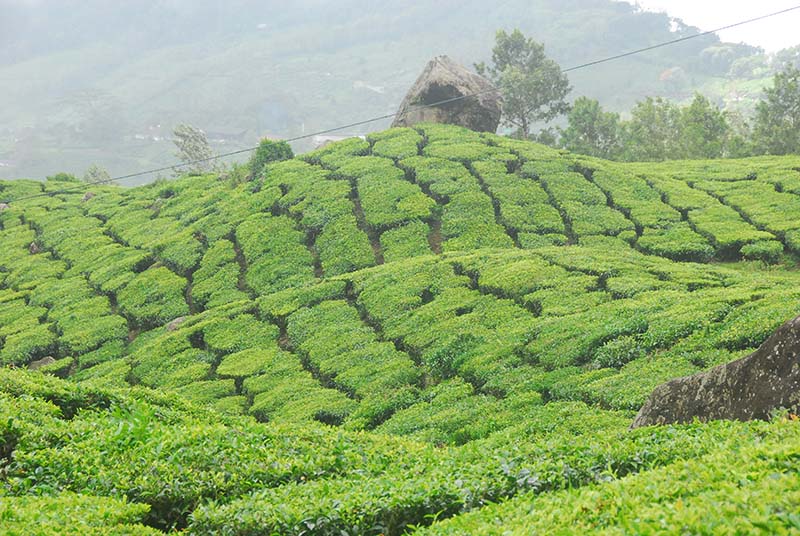
The resort looks very fancy as we approach it, and we are soon settled into our one bedroomed apartment, seemingly in the lap of luxury … but … it is cold and wet! This is indeed unexpected when we are well south of the tropic of cancer. It takes us a couple of days to sort the heating out in our room, but after that we are quite cosy as we watch the rain and the wind blowing the trees outside.
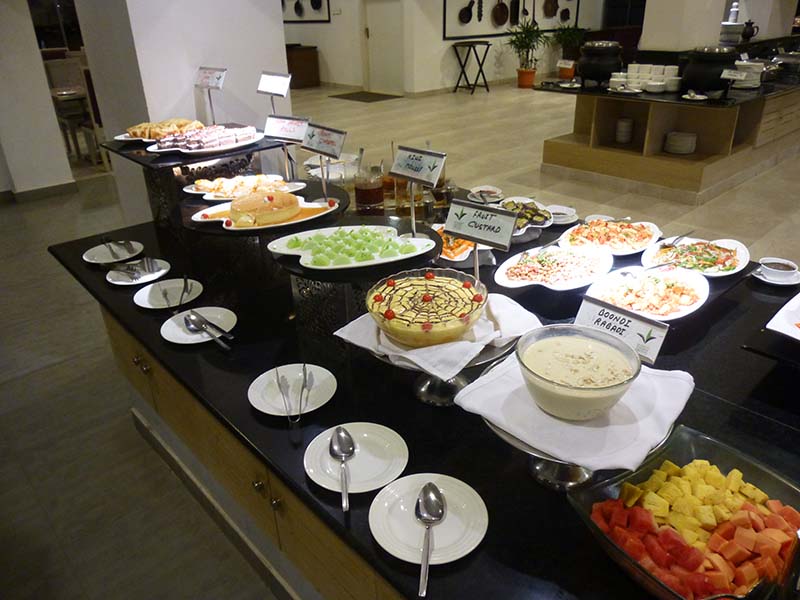
There is no choice but to eat at the resort; not much in the way of cafes are available in the village, so we opt for the buffet dinner and buffet breakfast. These cost the enormous sum (or so it seems to us) of $12.50 each all up for both meals. For dinner we are confronted with a choice of 15 different hot dishes (north indian, south indian and ‘continental’), with condiments by the dozen plus soups and multiple salads, hot butter naan or chapatis on demand (freshly cooked indian bread) followed by a host of deserts, fresh fruit and ice cream. Wow! Breakfast was the same. As we can’t quite manage curry for breakfast yet; it means we have to put up with freshly cooked omeletts, tomatoes, baked beans, toast-butter-marmalade, croissants, cinnamon buns, muffins and plenty of fresh tropical fruit. This did rather produce a tendency to over eat!
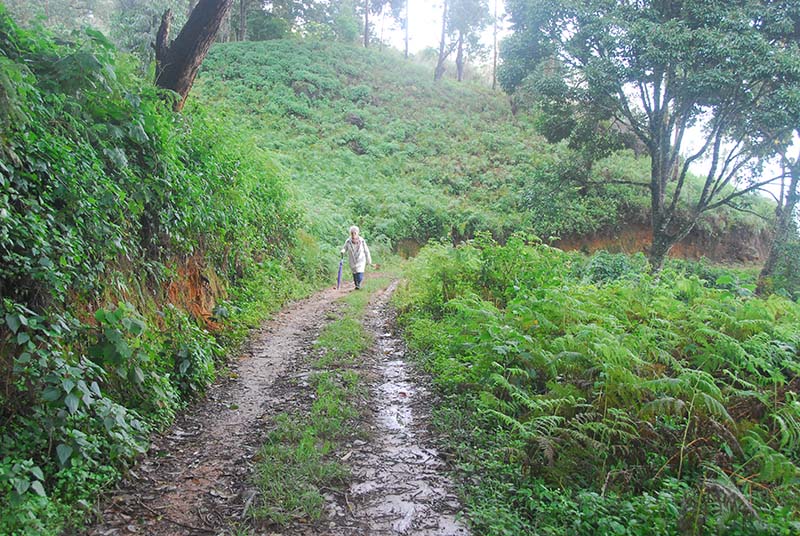
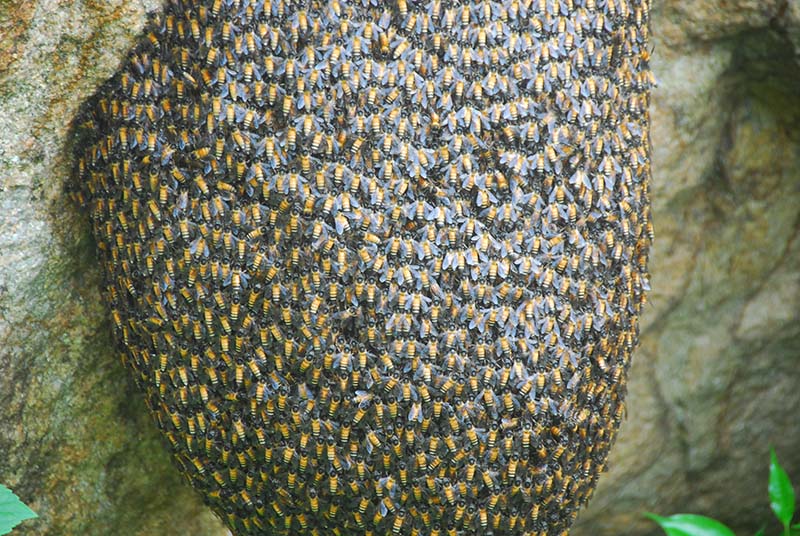
Mmmmm. With the incessant rain and wind this is beginning to feel like a gilded cage and although we manage a couple of walks, we are feeling the cold and missing the bustle of India. After five of our scheduled seven days the decision is made to forgo a couple of days and go back down to the warmth of the coast. Check out and into the taxi, and off back down to the plains to the town of Alleppey, famous as the starting point for the houseboats that cruise out into the Keralan backwaters. This area has hundreds of kilometers of waterways and lakes with villages dotted throughout.
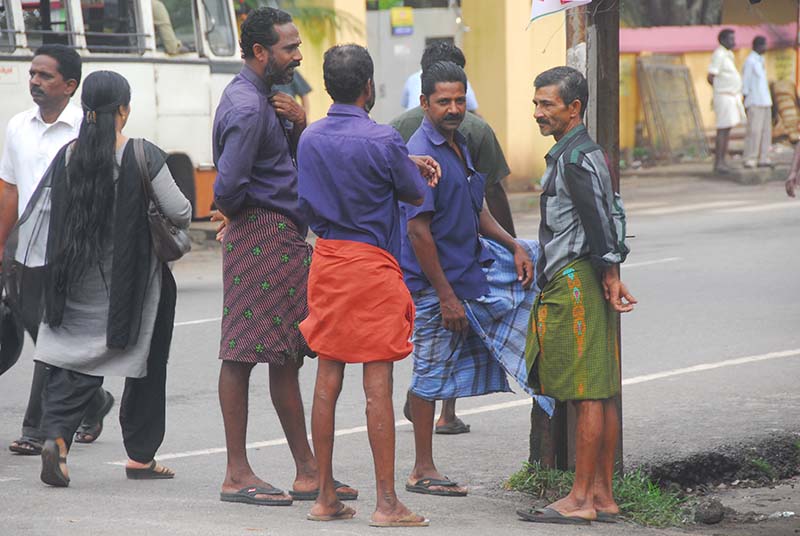
After an uncomfortable night in a small dark hotel room fighting off the mozzies, we are following a tip that one of the regular local ferries is a much better way to go than hiring an expensive houseboat. We are down at the boat jetty in time to catch the 8:20 ferry to a village with an unpronounceable name which we are told is a two hour round trip and which turned out to cost 160 rupees or $3 for both of us. The ferry has an open sided top deck and we have the front seats, indeed the whole deck to ourselves, with the locals preferring to stay downstairs.
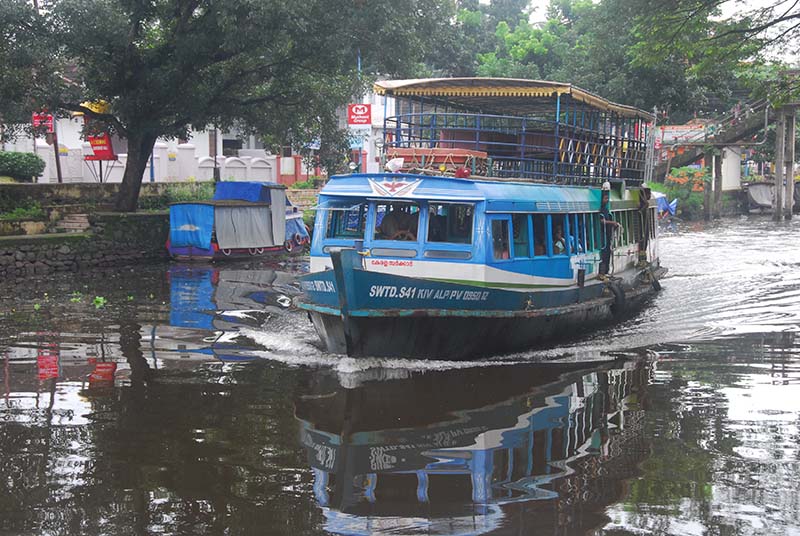
After a short trip down the town canal we are out into the waterways and what a magical place it is. The ferry stops at small jetties to take on passengers; mostly children on their way to school. Stretched out along the banks with flooded paddy fields behind, the villages are built amid this watery world; a world of boats where the family car is a long wooden canoe.
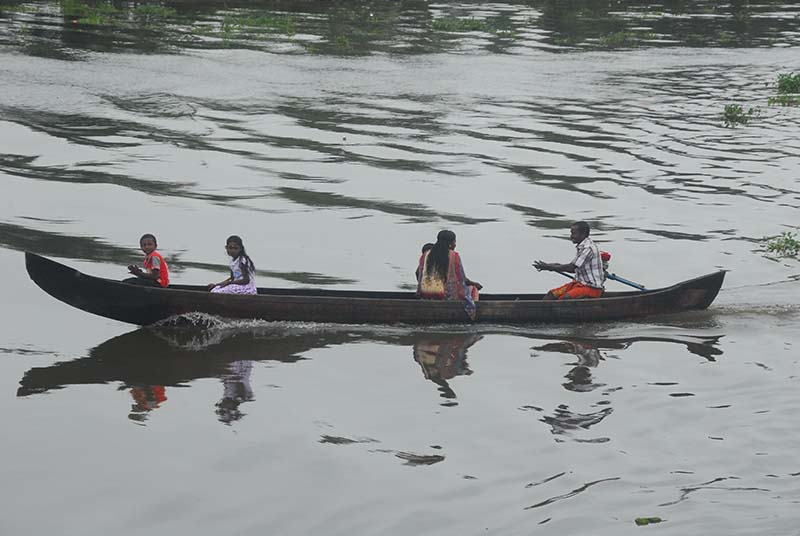
Passengers come and go; we pass several schools noisy with arriving pupils. Houseboats glide past with their passengers enjoying breakfast as they pass.
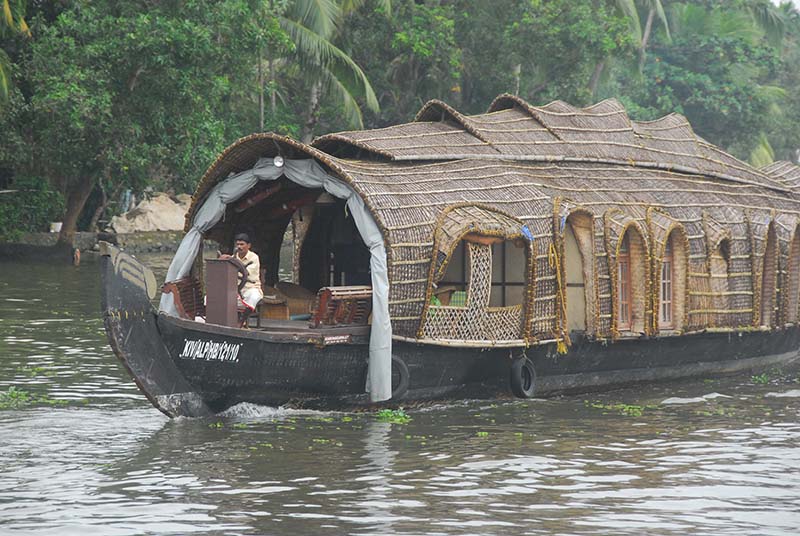
The monsoon has been heavy this year and there is evidence of sandbags and some houses are flooded. Not the rushing and crashing destuctive floods of the north of India (and queensland come to that), but the slow and quiet rise of the water level – when will it stop?
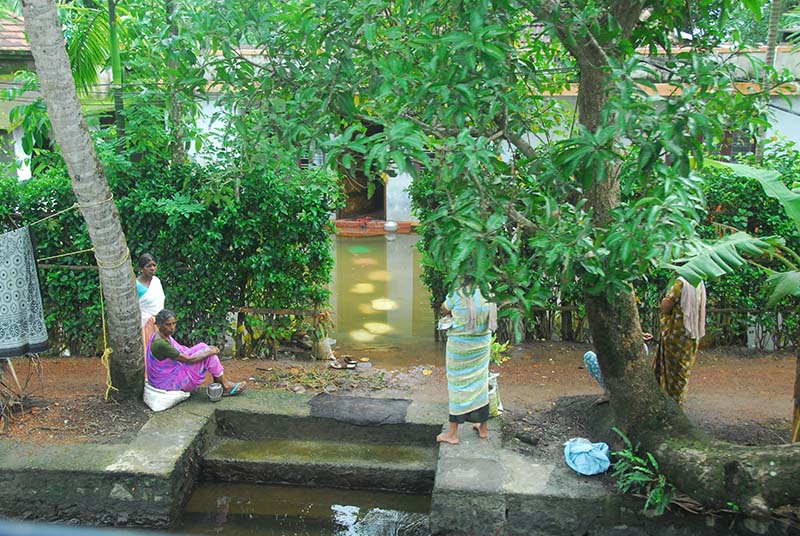
The two hours have flown by in this wonderland and here we are back at the boat jetty where we have found an alternative hotel, the KTC Guest House, and with the help of a tuk tuk move to our new, much lighter room with mozzie screens which is right next to the bus station ready for tomorrows journey south. We wander along the crowded streets with the continuous traffic of busses, trucks, tuk tuk’s, motorbikes, bicycles and people; shops and stalls show their wares. We eat at the Indian Coffee House, our old friend from Shimla. There must be a festival coming up because the flower sellers are doing a roaring trade threading jasmin flowers onto strings to adorn the sleek black hair of the women. The smell is so sweet.
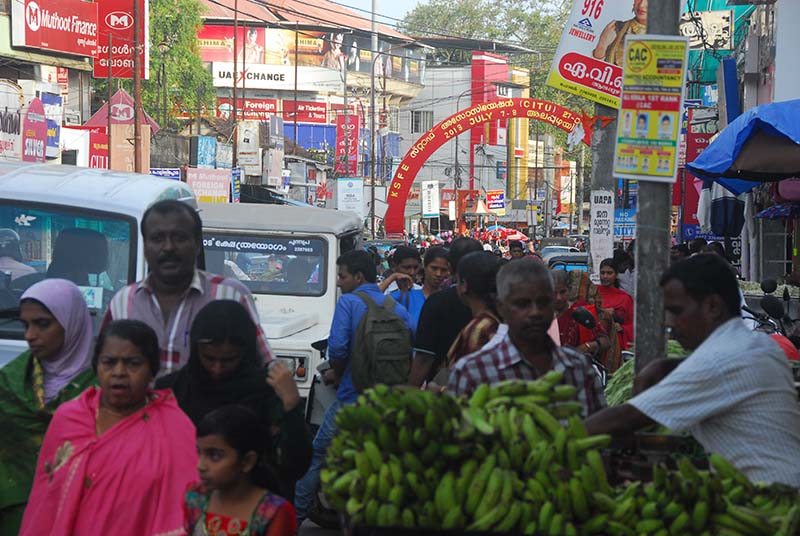
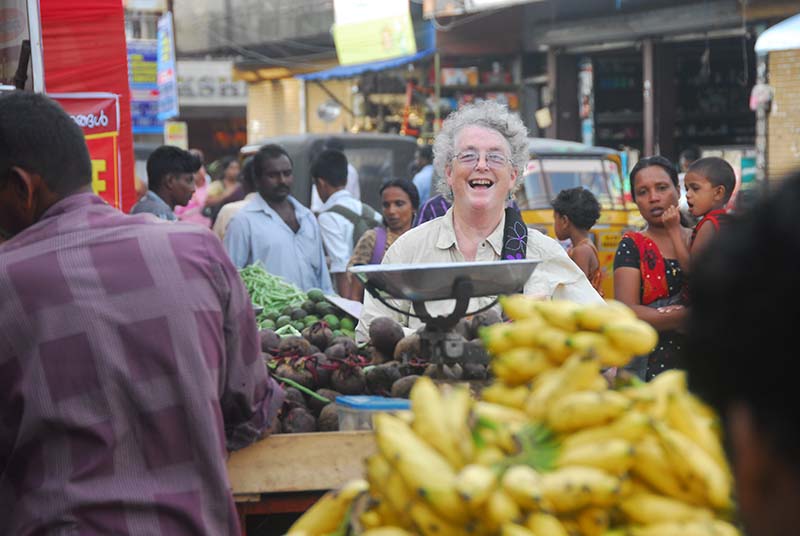
We have noticed along the way that the biggest and grandest banner advertisments on the highways are all for jewellery, and walking through the streets of the small (by indian standards anyway) town of Alleppey we are struck by the number of jewelers shops selling gold and diamonds and by how busy they are.
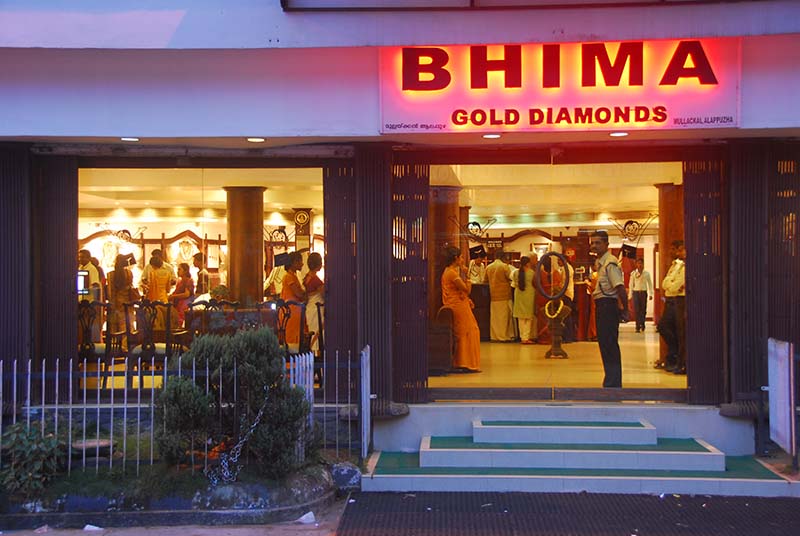
Often there are ten or fifteen people serving behind the counters and they are busy with the mass of customers. Where does all the money come from we wonder? Our taxi drivers tells us that many families have one member that works in the middle east, Dubai or Qatar, and so maybe that is the answer.
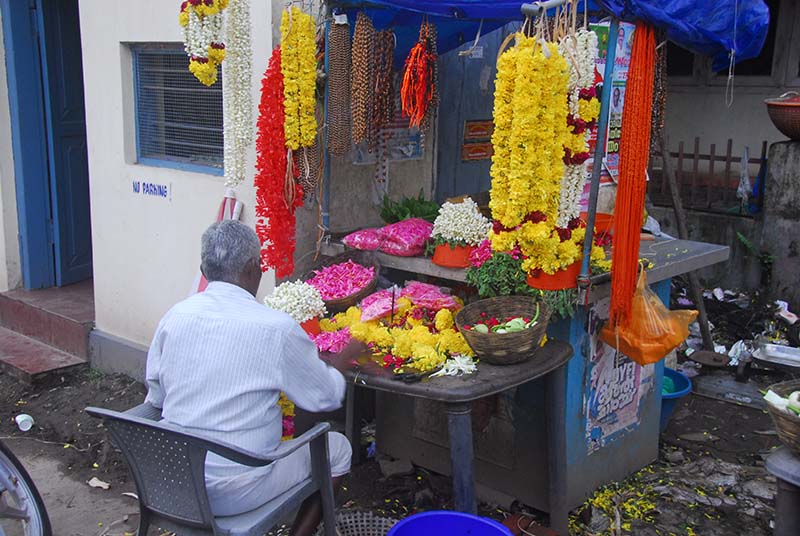
Meanwhile, we are checking out the buses. They are huge and red with no window glass. If it rains there is a blind to pull down. Seats are either wooden or some are lightly padded. How will this journey be, we are thinking? It takes around 4 hours to Trivandrum, more properly known as Thiruvananthapuram which is the capital of Kerela state. (The place names are very long here and I feel that to learn the local language, Malayalam, a tongue operation of some sort would be appropriate)
We have been told that the Trivandrum buses leave every twenty minutes and we carry our gear to the KSRTC bus stand and park it on “platform 1”. There is a bus standing there so I ask the driver if this is the bus we want. “No” he says with a big smile. “Oh” says I and get off again. Suddenly the driver gets off the bus and turns into an angelic figure. Beckoning us to follow, and then waving his arms around in a very mystical way, he manifests a chariot from thin air and urges us to board it. The chariot is a bright orange and white, air-conditioned deluxe express bus bound for Trivandrum which has two seats just for us. And for this luxury we pay $5 each for the 4 hour journey! We had asked so many people about deluxe busses and and they had all denied their existence including at the KSRTC enquiry office. Amazing!

Driving through the rain on the way south (window glass is so comforting somehow) we have time to reflect on the population. There are virtually no areas on the way that are free of houses and all the way the traffic is heavy. And this is Sunday … a day off in this christian state. What will is be like on Monday we ask ourselves and how will they deal with the ever increasing population with it’s ever increasing middle class who want the same bigger houses and bigger cars that we already have and all those things that go with increasing wealth?
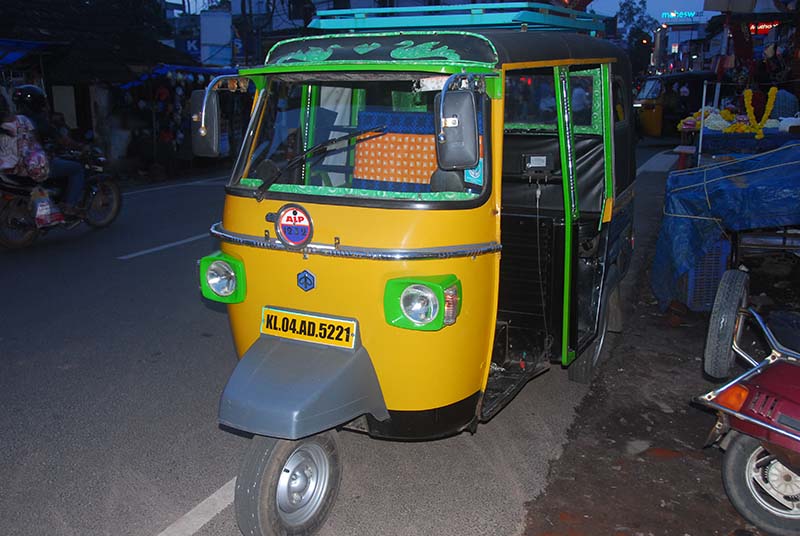
We have been dropped in the bus station and catch a tuk tuk down to Kovalum and a hotel on the beach where we can while away our last few days in India. The crescent of Lighthouse beach is lined with hotels, cafes and tourist shops … it is sheltered from the main wind and pleasing to the eye. The beach is quite busy, being Sunday, but now on Monday is it very quiet. There are some sunny periods, but also heavy rain. Red flags say don’t swim in here. Our third floor balcony looks out over the ocean with it’s giant waves and the sound of those waves is constant. We sit in a beachside restaurant and watch and contemplate the trip that is now so nearly over.
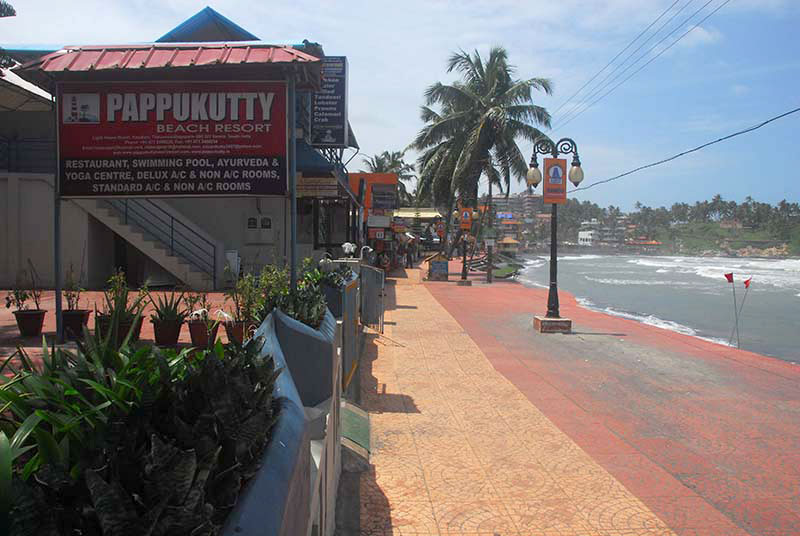
So here we are looking over the Arabian Sea on the Malabar coast of India. It’s easy going and relaxed here, and we have no particular wish to be busy with the long flight home coming up. For me, it has been really interesting to revisit the country after forty years and find a completely different place where the population has more than doubled since I was last here. More than this, the number of motorised vehicles on the road, both two wheel and 4 wheel has increased exponentially and it is probably this and the hugely increased middle classes, and so increased indian tourism, that give the country it’s current look and feel. A quiet drive through the small towns in the himalayan foothills in 1973 has become a hectic journey with blasting horns and crowded roads.
But we have really enjoyed the people. They have been friendly, helpful and courteous, and on occasions displayed a great sense of humour. The country we have seen has been beautiful and varied, although our favorite places were in Himachael Pradesh and the himalayan foothills, in particular Macloud Ganj. And then of course there is the food … cheap and plentiful and an infinite variety … and all those kind people in innumerable kitchens, who cooked it all for us – thank you, thank you. What luxury!
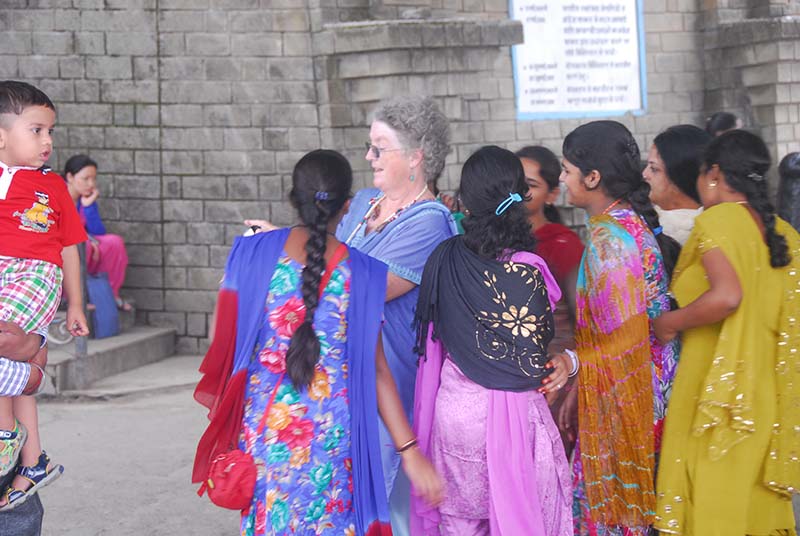
And what of Jacqui and I? After more than thirty years of living together, we have just spent ten weeks on the road in India and have found that we still really enjoy each others company.
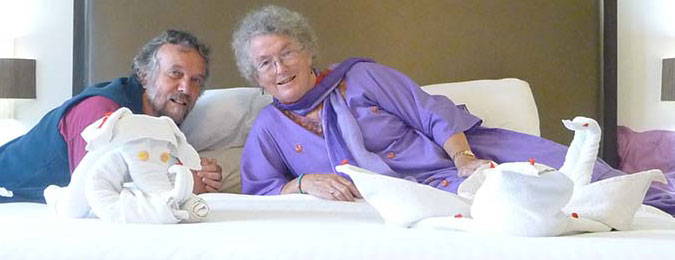
We have been delighted to share this adventure with each other … may we long continue to do so! I hope you have all enjoyed this little tale of a trip in India.
Lots of love to you all
Alan
PS …
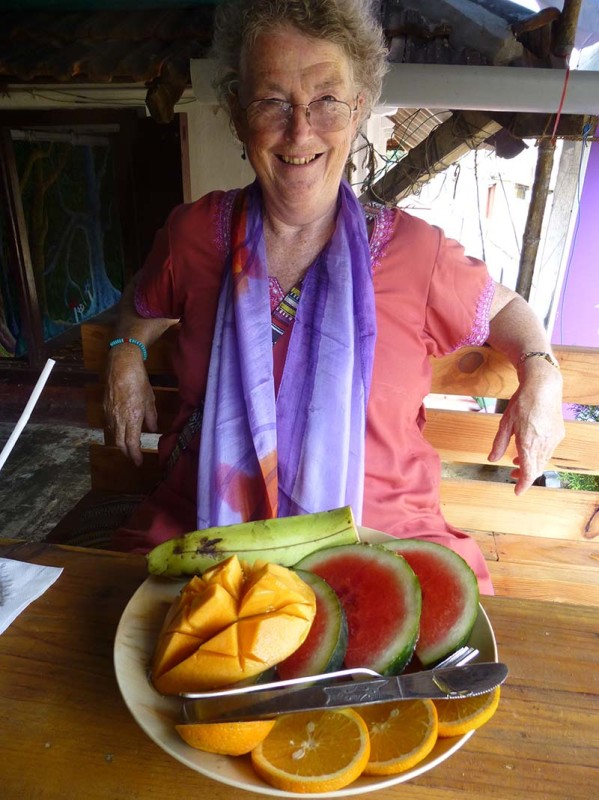

Love this Kerala story, Kochi, Allepey and Munnar. Mass in Malayalam at the Basilica one of life’s numinous experiences. Christmas in Kochi a silver foil shimmer Christmas, with lentils and litter, and love and the generosity od strangers a miracle for us several years back.
Hi Jacqui and Allan,
Thanks for this reminder of Kerala. Yes they really are an impressive people who have great pride in their part of the sub-continent -” God’s own country” etc.. I read in a p/back of short stories from the Idiom Bookshop that it’s “Church, Party and the Gulf” in that order for Keralans. Of course Family is so important it didn’t need a mention. The legend of St Thomas and a Christianity that’s un-Romanised and sans resurection is all extraordinary. Christmas day service in the Santa Cruz Basilica was packed with a multi-faith crowd and climaxed with flashing neon around that altar! Did you notice Kerala’s taste for mega-sculpture? Love it all.